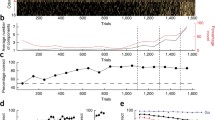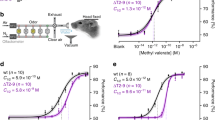Abstract
As an approach to a general theory of olfaction, different specific anosmia phenotypes characterized by different profiles of odorant sensitivities have been proposed for humans. In the present experiments, male inbred mice were tested for relative odorant sensitivity using a conditioned aversion technique and odors classified as primary or complex for humans. C57BL/6J and C57BL/10J mice appeared to be less sensitive to the primary odorant isovaleric acid than were males of seven other inbred strains (A/J, AKR/J, BALB/cJ, C3HeB/FeJ, DBA/2J, SJL/J, and SWR/J). In comparisons of C57BL/6J and AKR/J strains, the relative insensitivity of C57 to isovaleric acid did not generalize to the musklike primary odor of pentadecalactone or to the complex odor of amyl acetate. The C57BL/6J genotype may provide an animal model of a specific anosmia as characterized among humans.
Similar content being viewed by others
References
Amoore, J. E. (1967). Specific anosmia: A clue to the olfactory code.Nature 214:1095–1098.
Amoore, J. E. (1970).Molecular Basis of Odor, Charles C Thomas, Springfield, Ill.
Amoore, J. E. (1971). Olfactory genetics and anosmia. In Beidler, L. M. (ed.)Handbook of Sensory Physiology, IV: Chemical Senses, 1: Olfaction, Springer-Verlag, Berlin.
Amoore, J. E. (1975). Four primary odor modalities in man: Experimental evidence and possible significance. In Denton, D., and Coghlan, J. P. (eds.),Olfaction and Taste, V, Academic Press, New York.
Amoore, J. E., Venstrom, D., and Davis, A. R. (1968). Measurement of specific anosmia.Percept. Motor Skills,26:143–164.
Beets, M. G. J. (1971). Olfactory response and molecular structure. In Beidler, L. M. (ed.),Handbook of Sensory Physiology, IV: Chemical Senses, 1: Olfaction, Springer-Verlag, Berlin.
Garcia, J., Hankins, W. G., and Rusiniak, K. W. (1974). Behavioral regulation of the milieu interne in man and rat.Science 185:824–831.
Guillot, M. (1948a). Anosmies partielles et odeurs fondamentales.Compt. Rend. Acad. Sci. Paris 226:1307–1309. As cited in Beets (1971) and in Amooreet al. (1968).
Guillot, M. (1948b) Sur quelques caractères des phénomènes d'anosmie partielle.Compt. Rend. Soc. Biol. Paris 142:161–162. As cited in Beets (1971) and in Amooreet al. (1968).
Hodgman, C. D. (ed.), (1953).Handbook of Chemistry and Physics, Chemical Rubber Publishing Company, Cleveland, Ohio.
Horowitz, G. P., and Whitney, G. (1975). Alcohol-induced conditioned aversion: Genotypic specificity in mice. (Mus musculus).J. Comp. Physiol. Psychol. 89:340–346.
Kikuchi, T. (1973). Genetic alteration of olfactory function inDrosophila melanogaster.Japan. J. Genet. 48:105–118.
Michael, R. P., Keverne, E. B., and Bonsall, R. W. (1971). Pheromones: Isolation of male sex attractants from a female primate.Science 172:964–966.
Müller-Schwarze, D., Müller-Schwarze, C., Singer, A. G., and Silverstein, R. M. (1974). Mammalian pheromone: Identification of active component in the subauricular scent of the male pronghorn.Science 183:860–862.
Rozental, J. M., and Norris, D. M. (1975). Genetically variable olfactory receptor sensitivity inPeriplaneta americana.Life Sci. 17:105–110.
Rozin, P., and Kalat, J. W. (1971). Specific hungers and poison avoidance as adaptive specializations of learning.Psychol. Rev. 78:459–486.
Smith, J. C. (1971). Radiation: Its detection and its effects on taste preferences. In Stellar, E., and Sprague, J. M. (eds.),Progress in Physiological Psychology, Vol. 4, Academic Press, New York.
Tucker, D. (1963). Physical variables in the olfactory stimulation process.J. Gen. Physiol. 46:453–489.
Tucker, D. (1971). Nonolfactory responses from the nasal cavity: Jacobson's organ and the trigeminal system. In Beidler, L. M. (ed.),Handbook of Sensory Physiology, IV: Chemical Senses, 1: Olfaction, Springer-Verlag, Berlin.
Whissell-Buechy, D., and Amoore, J. E. (1973). Odor-blindness to musk: Simple recessive inheritance.Nature 242:271–273.
Wilcoxon, H. C., Dragoin, W. B., and Kral, P. A. (1971). Illness-induced aversions in rat and quail: Relative salience of visual and gustatory cues.Science 171:826–828.
Wysocki, C. J., and Tucker, D. (1975). Preliminary investigations of olfactory deficits in mice. Paper presented at the annual meeting of the Behavior Genetics Association, Austin, Texas, March 20–22.
Author information
Authors and Affiliations
Additional information
Supported in part by U.S. Public Health Service Grants MH-11218, NS-08814, and MH-05116 and by an award from the Florida State University Committee on Faculty Research Support. Portions of the data were presented at the meeting of the Behavioral Genetics Association, Austin, Texas, March 1975.
Rights and permissions
About this article
Cite this article
Wysocki, C.J., Whitney, G. & Tucker, D. Specific anosmia in the laboratory mouse. Behav Genet 7, 171–188 (1977). https://doi.org/10.1007/BF01066005
Received:
Accepted:
Issue Date:
DOI: https://doi.org/10.1007/BF01066005




